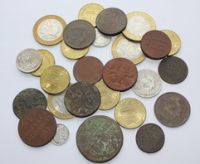On the fate of coin stamps of the St. Petersburg Mint
 Mikhail Ivanovich Smirnov, the archivist of the St. Petersburg Mint, published an interesting article in the 6th issue of the Old Coin: “The Mints Cabinet and the Museum of the Mint of St. Petersburg”. Among the problematic issues, the central place in it was taken up by the question of the fate of coin stamps of the St. Petersburg Mint, the solution of which, as the author points out, encounters difficulties. Recall the provisions formulated by him, which are, in his opinion, the starting point for solving the problem posed.
Mikhail Ivanovich Smirnov, the archivist of the St. Petersburg Mint, published an interesting article in the 6th issue of the Old Coin: “The Mints Cabinet and the Museum of the Mint of St. Petersburg”. Among the problematic issues, the central place in it was taken up by the question of the fate of coin stamps of the St. Petersburg Mint, the solution of which, as the author points out, encounters difficulties. Recall the provisions formulated by him, which are, in his opinion, the starting point for solving the problem posed.
1. M.I. Smirnov emphasizes that “the heads of mints already from the 18th century made sure that exemplary stamps, queen cells, forms, etc. were preserved. This need was motivated by the occurrence of difficulties in the examination of the authenticity of coins, and later in connection with the spread of collecting numismatic items. Thus, the stamp archive began to take shape. Only the unusable, defective and waste tools were destroyed. ”
2. In the archival files of the Mint’s Medal Chamber, M. I. Smirnov was “lucky to discover,” as he writes, a leave (that is, a copy) of the catalog of coin stamps kept at the Mint at that time, compiled in March 1847. According to M. I. Smirnov, the purpose of this catalog, containing a list of 1349 postmarks from the reign of Vasily Dmitrievich (1389-1424) to 1846, “leaves no doubt” – it is the same as the purpose of the one kept in the Hermitage and published by I. G. Spassky catalog of Russian coins, compiled in the reign of Catherine II: “the intensification of collecting in the capital required from the leadership of the Mint constant care about the preservation of the stamp archive.” Both catalogs, M. I. Smirnov believes, clearly demonstrate this concern.
3. Without giving, unfortunately, data on how many and precisely which old coin stamps are currently stored at the Mint, M. I. Smirnov in general terms indicates a loss of the “old stamp tool”, a loss, as it is not difficult to understand , devastating; he regards this loss as one of the secrets of the Mint, the disclosure of which is an important but difficult task.
4. M.I. Smirnov sees the difficulty of solving this task in the fact that although the “partial” destruction of the stamps that had come into complete disrepair could have been done in the middle of the 19th century, and the stamps of dubious origin in 1890 due to the cessation of the manufacture of replicas, however, the main loss of coin stamps occurred, in his opinion, in 1917, during the evacuation of the exhibits of the Mint’s Cabinet Office, and the documents related to this evacuation were not preserved, they also died. The idea of the death of the bulk of coin stamps during the evacuation of Mikhail Ivanovich is carried out not only in this article, but also in his other works, in particular in the article “The Russian Revolution of 1917 and Numismatics”, where he formulated it very clearly:
“… in the evacuation, archival documents, stamp tools of the XVIII-XX centuries and numismatic collections were lost or completely disappeared” (1), as well as in a recent monograph on the history of the St. Petersburg Mint, where this thought is repeated: “.. .In 1917, archival materials of the 18th-20th centuries, stamp tools and numismatic collection were sent from here (i.e., from Petrograd – V. B.). Unfortunately, the stamp and documentary archives died during the evacuation “(2). The question is complicated, according to M. I. Smirnov, also by the fact that the original inventories, compiled during the re-evacuation, were not preserved, they apparently died during the Great Patriotic War of 1941-1945.
Ascertaining the death of the old stamp toolkit in 1917-1918, MI Smirnov notes with regret: “… we didn’t come close to unraveling the secrets of the Mint. We didn’t give positive results and repeated appeals in the periodical press or information on the subject. ” At the same time, he expresses the hope that “not all the ways have been passed to the end and all is not lost. Whatever the final of the story that has unfolded before us, we hope to find it out, including with the help of readers.”
Responding to this appeal, we decided to share the documentary information about the “secrets of the Mint” that we have, without pretending to elaborate and detailed the issue, which, of course, requires extensive research, but with the aim, first of all, to point out the need to solve his, guided by a fundamentally different approach than the approach of M. I. Smirnov; at the same time, a number of problems arising from such an approach will be touched on in passing.
First of all, it is necessary to abandon the conviction that the heads of the mints “have already been concerned since the 18th century that exemplary stamps … should be preserved” and that only the unsuitable, defective and used tools were destroyed. Understanding the scientific and historical and cultural value of the monetary toolkit was not even in the middle of the XIX century, and even more so in the XVIII century.




